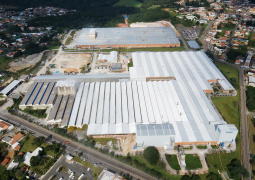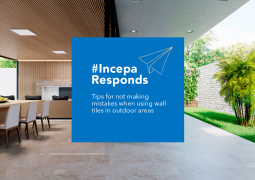Incepa Responds: complete guide with all the specifications of Incepa’s ceramic tiles

Choosing which ceramic tiles will be part of our home is not always an easy task. Since, in addition to aesthetic care, it is also necessary to know the technical specifications that involve the pieces.
In this text from Incepa Responds, we will address precisely these technical issues that often go unnoticed. While reading, you will learn about: the nomenclatures we use in our pieces, the best environments to install ceramic tiles, and their possible variables. Keep reading and check it out!
Porcelain tile finishes
Knowing the different finishes of porcelain is essential to know which product is ideal for the environment, aiming both aesthetics and functionality and safety of residents. Next, check out the different types of finishing of Incepa porcelain tiles.
Technical porcelain
They are products that do not receive enamel and have low water absorption, which guarantees good mechanical resistance. Technical porcelain tiles are manufactured in 03 types of finish:
01. Polished
Porcelain tiles with a polished finish have low water absorption and a shiny surface. They can be applied in dry indoor areas, such as bedrooms and living rooms, or in wet areas, such as the bathroom.
Regarding maintenance care, it is recommended to choose neutral products, with a pH of 7, when cleaning. It is important to pay attention to this point, as there are several products on the market with a high acidity and alkalinity index that can stain the pieces.
02. Satin
The satin finish product has a “soft” and smooth surface. Like the polished ones, they can be used in dry or wet indoor areas, with heavy traffic.
03. Natural
Natural finish porcelain tiles have a matt surface. This product falls into the Grip category as it has a coefficient of friction between 0.40 and 0.49, making it ideal for wet indoor areas, such as laundry rooms and bathrooms with showers.
Enameled Porcelain
Enameled porcelain tiles are made from special raw materials and, as the name suggests, have an enameled and shiny surface. This layer of enamel allows the plates to contain various prints and patterns.
Another characteristic is that its water absorption is also low (<0.5%) and it has good resistance. In addition, the enamels receive ABS technology, which provides greater slip resistance and 30% more grip.
Tuttomassa porcelain
The Tuttomassa porcelain tile is produced with Incepa’s exclusive technology. Its great differential is the colored mass applied evenly, from its base to the surface.
This technique allows porcelain tiles to be created with different shapes of reliefs and textures, providing a natural and organic effect for each piece.
Porcelain tiles for swimming pools
Among the types of finishes, it is also important to highlight those that were developed for swimming pools, as these products need to follow specific technical characteristics. At Incepa, you will find the Oceanic line, created especially for this purpose.
With a low water absorption (< 0.5%), the parts present low expansion by humidity, high mechanical resistance, gum effect, and easy cleaning and maintenance. In addition, they have a minimum joint of 1mm, are resistant to chlorine, and allow the use of common grout.
Extra tip
When designing your pool, in addition to choosing a sunny spot, you should think about other important points, such as:
- Surrounding vegetation: avoid planting tall trees in the area close to the pool, as they can cause unwanted shadows. Also, remember that plants that lose leaves throughout the year can end up accumulating in your pool.
- Depth: to avoid accidents, the minimum depth indicated when building your pool is 1m40cm.
- Finishing: bet on good wall tiles, non-slip floors, and edges without corners, increasing the safety of the pool.
Porcelain tile with HD printing
Another way of finishing that you can find in Incepa porcelain tiles is those with high-definition digital printing. Thanks to HD technology, it is possible to perfectly reproduce all the veins, nuances and designs found in marble, wood, and natural stones.
It is worth mentioning that this type of finish reaches the entire surface of the ceramic body, including irregular surfaces and reliefs, creating harmonious compositions full of personality.
Thanks to HD printing technology, the veins, nuances, and imperfections of nature are faithfully reproduced in the pieces, creating harmonious compositions full of personality.
Lapped porcelain tiles
Finally, we have ceramic tiles with a lapped finish, which are partially polished. Its surface has shiny and matte spots. Undoubtedly, a sophisticated finish that reflects good taste and elegance
Porcelain tiles with ABS finish
The ABS finish is exclusive to Roca Brasil Cerámica, a group that includes the Roca and Incepa brands. This type of finish has a Wet Friction Coefficient >70, which guarantees parts with 30% greater adhesion than those found on the market.
For this reason, porcelain tiles with an ABS finish are an option for wet areas, where slip-resistance is critical. Some examples are pool decks, external stairs, and ramps with up to 10% slope.
Despite the high coefficient of coefficient and wet friction, the surface of the pieces is not rough when compared to natural stones or conventional non-slip wall tiles.
Edges
Now that you know the different finishes of porcelain tile, it’s time to tackle the next topic: the edges of the piece. We selected 04 models that you need to know before choosing the wall tile for your home.
01. Bold edges
This edge model is the most common and known of ceramics. Its main feature is the rounded edges, which results in pieces with uneven sides and surfaces.
This particularity makes the spacing between the pieces greater, with joints of 03 mm, being necessary to use grout for application. On the other hand, it is a product with a lower purchase price and easy installation.
02. Rectified edges
For those who want a more uniform finish, we recommend pieces with a ground edge. The big difference from plates with this finish is the straight and precise edges.
In this way, it is possible to install them evenly and aligned. In addition, it is not necessary to use both grout and bold edges, which results in joints with less thickness.
By having a regular finish, they cause an effect of visual amplitude and add sophistication and elegance to the environment. Another point worth mentioning is the minimum joints of only 1mm between the pieces when settled.
03. Flat Edges
The Flat edge is an exclusive Incepa technique that provides greater flatness on the surface of the pieces. Thus, the products that have this border model are contemplated with the decoration, reaching them in their entirety, eliminating the traditional “white border”.
The technique is used in ceramic tiles in 25x60cm, 33x45cm, and 33x60cm formats, without relief. When applied, the pieces create the effect of a rectified product, facilitate handling and present a better cost-benefit when compared to rectified porcelain tiles.
04. Dry joints
This type of border is suitable for those who want an environment that appears to be covered by a single piece. The plates of this model are applied without space between them, providing the effect of a single piece in which we do not notice the seam between the pieces.
Indications for use
In addition to the types of finish and edges of ceramic tiles, it is important to know the best indication of use for each product. In this scenario, there are technical criteria responsible for classifying a part according to its resistance to wear and scratches.
This classification is called “Usage groups” and has a scale ranging from “G1” to “G6”. Knowing it will help you choose the ideal wall tile, taking into account the trafficability of the place where it will be applied. Check out how the parts are divided:
- G1: Exclusive use on walls.
- G2: use in residential bathrooms and bedrooms.
- G3: use in residential areas without communication with external areas.
- G4: use in all residential premises.
- G5: Use in all residential premises and medium-traffic commercial environments.
- G6: use in all residential premises and high-traffic commercial environments.
Tone and color variation
In addition to all the topics covered, it is also important to pay attention to the color variations and shades of the piece. Having this knowledge, you won’t have to deal with unforeseen events. The plates can vary from “V1” to “V4”, with each of these classifications going from the most uniform to the least uniform. Check the scale:
- V1: pieces with the smallest possible variation in tone and color. The differences are very small and subtle.
- V2: the pieces may have a slight variation in tone, nothing extreme.
- V3: wall tiles with a moderate shade variation. They present changes of prints in the same box but bring similar and complementary nuances, which help in the achievement of an environment with an organic/natural aspect.
- V4: this is the maximum level of variation that wall tiles can exhibit. When classified as V4, the pieces are random and can be completely different from each other.
After all this guide is full of technical and relevant information for you to choose the pieces that will decorate your environment, it’s time to choose your wall tile with great tranquility and focus.
Remember that at Incepa you will find everything you need to give a special face to your architectural project. Let’s build together the home, corporate, and/or commercial space you’ve always dreamed of?



